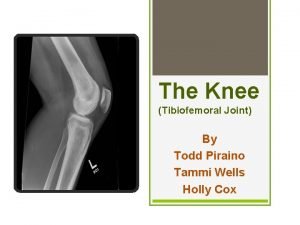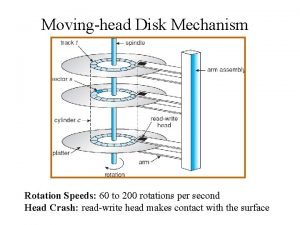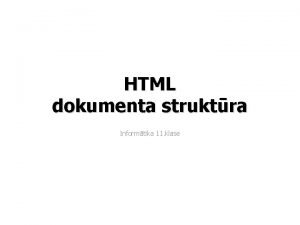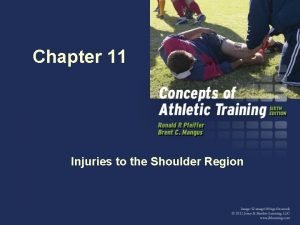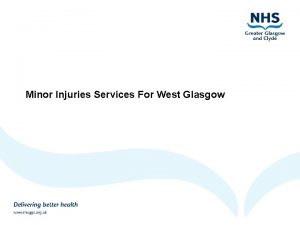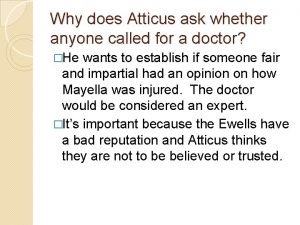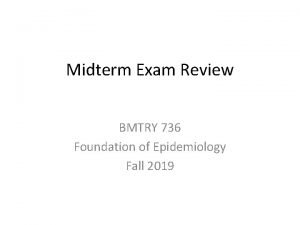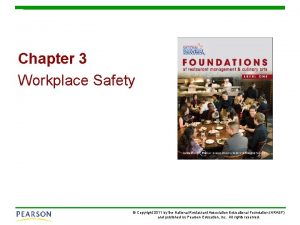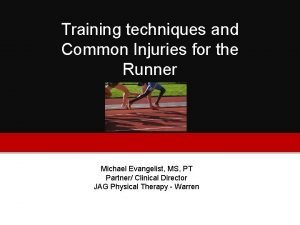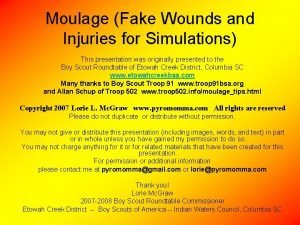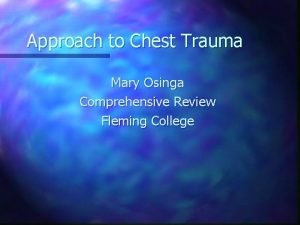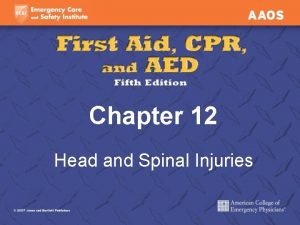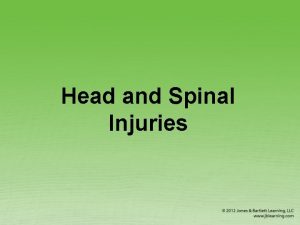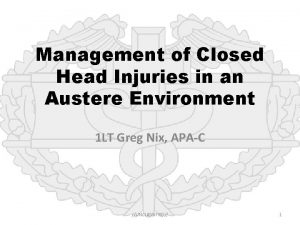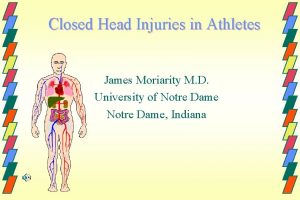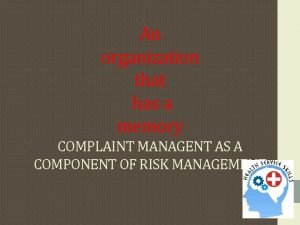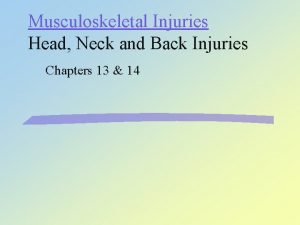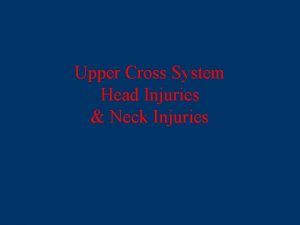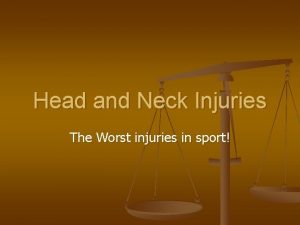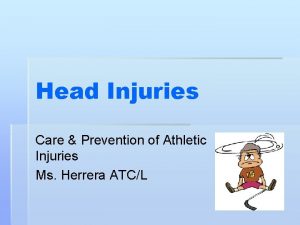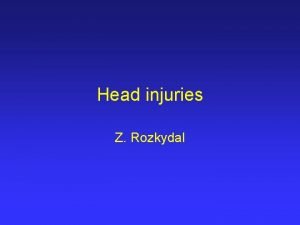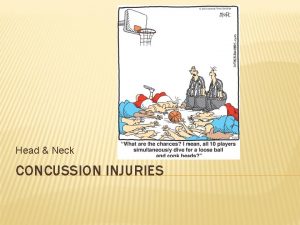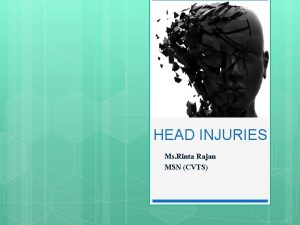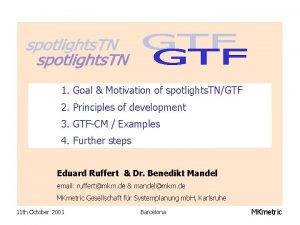Current managent of closed head injuries Spotlights Zeiad

















































- Slides: 49

Current managent of closed head injuries Spotlights Zeiad Fayed MD Lecturer of neurosurgery Ain shams university

How serious ? • Trauma is the leading cause of death in the developed world in persons aged 1 - 45 years. • In polytraumatized patients the head is the most commonly injured part.

How old. . Male Or female ? • Head injuries primarily occur in young adults. • Males are affected more than females. • The highest incidence occur in September. . Mostly in Fridays , Saturdays and Sundays

What are the causes?

Motor vehicle accidents

Falls from Height


Assaults

How to classify head injuries ? According to Mechanism Severity Morphology

According to mechanism • Closed • Penetrating

Acoording to severity

According to Morphology Head injuries Intracranial injuries Skull fractures

Intracranial injuries • Focal - extradural - subdural - cerebral contusions - traumatic subarachnoid - traumatic intracerebral • Diffuse - mild concussion - Classic concussion - Diffuse axonal injury


Skull fractures • Vault - non depressed (fissure ) - depressed • Base

Fissure fracture


Depressed fracture


Fracture base




Extradural Hemorrhage




Indications of Surgery • Any Symptomatic EDH • Any EDH > 1 cm

Acute Subdural hematoma



Chronic Subdural hematoma


Cerebral contusion

Traumatic Subarachnoid hemorrhage

Traumatic Intracerebral hematoma

Management of Head injuries



Management of Mild head injury Risk factors • • • Post traumatic amnesia > 60 min Retrograde amnesia > 30 min Loss of conciousness > 30 min Clinical signs of skull fracture Headache Vomiting Focal neurological deficit Seizure Age < 2 y Age > 60 y Coagulation disorder High energy accident

Management of severe Head injury • • History Primary survey ( ABC ) Secondary survey ( cervical clearence ) General examination Neurologic examination Therapeutic agents CAT scan



Therapeutic agents • • • Mannitol. Steroids. Lasix. Antiepileptic. IV fluids. Hyperventilation.





Thank You!
 Chapter 28 head and spine injuries
Chapter 28 head and spine injuries Chapter 21 caring for head and spine injuries
Chapter 21 caring for head and spine injuries Normally open, timed-closed contact symbol
Normally open, timed-closed contact symbol A closed path that electric current follows is a(n) ______.
A closed path that electric current follows is a(n) ______. Why is galethebege excommunicated from the church
Why is galethebege excommunicated from the church Holding current and latching current
Holding current and latching current Phase to phase voltage
Phase to phase voltage Intrinsic semiconductor
Intrinsic semiconductor Why must the electrode holder be correctly sized?
Why must the electrode holder be correctly sized? Drift current density unit
Drift current density unit Energy band diagram of pn junction diode
Energy band diagram of pn junction diode The value of vgs that makes is approximately zero
The value of vgs that makes is approximately zero Touch current vs leakage current
Touch current vs leakage current Lesson 4 three-phase motors
Lesson 4 three-phase motors Balanced delta-wye connection
Balanced delta-wye connection Line current and phase current
Line current and phase current Non planar circuit
Non planar circuit Drift current and diffusion current in semiconductor
Drift current and diffusion current in semiconductor Long head short head bicep
Long head short head bicep Difference between dividing head and indexing head
Difference between dividing head and indexing head Shin body part
Shin body part The tone unit
The tone unit The attacking firm goes head-to-head with its competitor.
The attacking firm goes head-to-head with its competitor. Tonic syllable
Tonic syllable The head of moving head disk with 100 tracks
The head of moving head disk with 100 tracks Html tagi
Html tagi Pro minent
Pro minent Moving head disk mechanism in os
Moving head disk mechanism in os Chapter 11 injuries to the shoulder region
Chapter 11 injuries to the shoulder region Stobhill miu
Stobhill miu Describe mayella’s injuries.
Describe mayella’s injuries. Intentional injury examples
Intentional injury examples An epidemiologic survey of roller skating injuries
An epidemiologic survey of roller skating injuries Chapter 12 lesson 2 improving your fitness
Chapter 12 lesson 2 improving your fitness Chapter 14:1 using body mechanics
Chapter 14:1 using body mechanics Hunger games chapter 21 questions and answers
Hunger games chapter 21 questions and answers Chop saw injuries
Chop saw injuries Unit 15:9 providing first aid for bone and joint injuries
Unit 15:9 providing first aid for bone and joint injuries Pa wc bureau
Pa wc bureau Which osha document summarizes occupational injuries
Which osha document summarizes occupational injuries Bo taoshi injuries
Bo taoshi injuries Chapter 11 assessment and evaluation of sports injuries
Chapter 11 assessment and evaluation of sports injuries Pack-strap carry meaning
Pack-strap carry meaning Common track and field injuries
Common track and field injuries Glycerin and gelatin fake skin
Glycerin and gelatin fake skin Chapter 4 preventing injuries through fitness
Chapter 4 preventing injuries through fitness Chapter 14 bleeding shock and soft tissue injuries
Chapter 14 bleeding shock and soft tissue injuries Strickler spine and sport
Strickler spine and sport Deadly dozen itls
Deadly dozen itls Injuries first aid
Injuries first aid


















